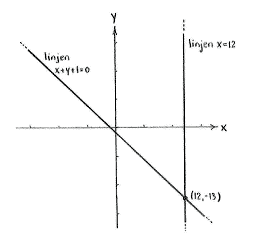Solution 2.2:6d
From Förberedande kurs i matematik 1
(Difference between revisions)
m (Lösning 2.2:6d moved to Solution 2.2:6d: Robot: moved page) |
|||
| Line 1: | Line 1: | ||
| + | At the point where the lines cut each other, we have a point that lies on both lines and which must therefore satisfy the equations of both lines: | ||
| + | |||
| + | |||
| + | <math>x+y+1=0</math> | ||
| + | and | ||
| + | <math>x=12</math>. | ||
| + | |||
| + | We obtain the solution to this system of equations by substituting | ||
| + | <math>x=12</math> | ||
| + | into the first equation | ||
| + | |||
| + | |||
| + | <math>12+y+1=0\ \Leftrightarrow \ y=-13</math> | ||
| + | |||
| + | which gives us the point of intersection as | ||
| + | <math>\left( 12 \right.,\left. -13 \right)</math>. | ||
| + | |||
| + | |||
{{NAVCONTENT_START}} | {{NAVCONTENT_START}} | ||
[[Image:2_2_6_d.gif|center]] | [[Image:2_2_6_d.gif|center]] | ||
| - | + | ||
{{NAVCONTENT_STOP}} | {{NAVCONTENT_STOP}} | ||
Revision as of 11:39, 18 September 2008
At the point where the lines cut each other, we have a point that lies on both lines and which must therefore satisfy the equations of both lines:
\displaystyle x+y+1=0
and
\displaystyle x=12.
We obtain the solution to this system of equations by substituting \displaystyle x=12 into the first equation
\displaystyle 12+y+1=0\ \Leftrightarrow \ y=-13
which gives us the point of intersection as \displaystyle \left( 12 \right.,\left. -13 \right).

